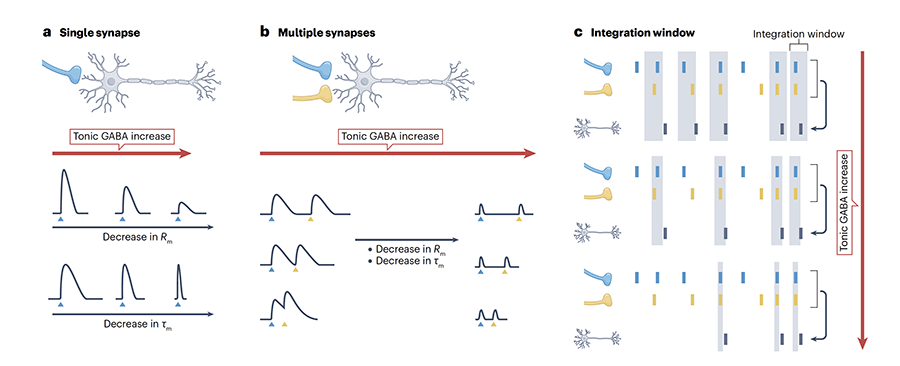New Comprehensive Guidelines for GABA, a Key Neurocognitive Substance
Professor Cheong Eunji’s team publishes new comprehensive guidelines for GABA, a key neurocognitive substance
Established guidelines for the principles of tonic GABA—an information filter in the brain
Published in Top Neuroscience Review Journal “Nature Reviews Neuroscience”

Professor Cheong Eunji’s team in the Department of Bioetechnology at the Yonsei University College of Life Science and Biotechnology recently published new comprehensive guidelines on GABA, a key neurocognitive substance and suspected cause of various brain disorders.
Postdoctoral researcher Kwak Hankyul, Director Lee C. Justin of the Institute for Basic Science (IBS) Cognition and Sociality Research Foundation, and Ko Woo-Hyun’s research team collaborated to conduct this study which involved the systematic elucidation of the principles governing the regulation and functioning of GABA in the brain.
The activities of the human brain are controlled by the modulation of two fundamental processes: excitatory signaling that activates neurons, and inhibitory signaling that restrains neuronal activation. These processes have mainly been known to be predominantly influenced by two neurotransmitters, glutamate and GABA, respectively. The orchestration of excitatory and inhibitory signaling pathways hinges on the movement of ions across cell membranes. GABA, an inhibitory neurotransmitter, chiefly employs chloride ions to mediate its inhibitory effects. Continuous inhibitory influence induced by GABA is referred to as “tonic GABA currents.”
Despite the extensive research devoted to GABA, a pivotal neurocognitive signaling molecule linked to various brain disorders, as yet, there has been no comprehensive study that systematically consolidates knowledge regarding the governing principles of GABA regulation and its implications for signal transmission and cognitive function.
Thus, the researchers mentioned above reviewed the existing literature on the principles of GABA regulation in the brain and the specific molecular and cellular mechanisms through which tonic GABA currents affect signaling and cognitive functions.
In their review paper, the researchers emphasized the pivotal role of astrocytes in regulating the quantity of GABA within the brain, and highlighted the effects of tonic GABA currents on various cognitive functions. In particular, they introduced the concept of a “GABA tone” to define the level of GABA that maintains a consistent tonic GABA current in the brain. Here, “tone” refers to the maintenance of a consistent pitch in music, while “GABA tone” signifies the quantity of GABA maintained within the brain.
Contrary to the prevailing belief in the scientific community that the inhibitory effect of GABA currents is due to hyperpolarization, where the membrane potential of neurons decreases in the opposite direction of active potential, this research team demonstrated that it instead occurs through shunting inhibition, a phenomenon in which the amplitude of synaptic potential decreases due to localized reductions in resistance.
Although GABA is inhibitory by nature, it also plays a role in finely distinguishing sensory signals, much like the aperture in a camera adjusting the exposure value to capture a clear photograph. The research team explained that “GABA tone” filters out noises amid several neural signals, ensuring the optimal contrast for differentiating information.

[Figure. Shunting Inhibition by the GABA tone adjusts the time window for the integration of multiple synaptic signals, filtering out noise and delivering synchronized signals with precision, thereby enhancing the accuracy of signal discrimination.]
Furthermore, the researchers proposed various functions associated with tonic GABA currents, such as learning, memory, biological rhythms, wakefulness, and motor control, underscoring the need for further research on the additional cognitive functions of GABA tone.
Professor Cheong Eunji remarked that “The GABA tone acts as a vital filter within the brain, preserving essential information and likely participating in various cognitive functions, for which research is underway. Since the paper’s online release, we have observed a surge in requests for theoretical explanations, which shows the heightened interest in GABA research.”
Lee C. Justin the director of the IBS, stated that “The world is paying attention to research on the functions of tonic GABA currents that has branched off from research on astrocytes. We hope that our research achievements serve as a comprehensive guideline for GABA research.”
This groundbreaking study was published in the September issue of “Nature Reviews Neuroscience,” the most prestigious review journal in the field of neuroscience (Impact Factor = 38.755).
Recommended Articles
Professor Myeong Min Lee
A QUIRKY twist of fate: understanding epidermis cell differentiation in plants
Professor Jihyun F. Kim
Microbial Mercenaries for Plant Disease Resistance Ungrounded